Comparative Study of Pore Structure Characteristics between Mudstone and Coal under Different Particle Size Conditions
Abstract
:1. Introduction
2. Materials and Methods
2.1. Chemicals and Instruments
2.2. The Preparation of Mudstone and Coal Samples
2.3. Experimental Methods
3. Results and Discussion
3.1. The MIP Measurement
3.2. The LT-N2A Measurement
4. Conclusions
Author Contributions
Funding
Institutional Review Board Statement
Informed Consent Statement
Data Availability Statement
Acknowledgments
Conflicts of Interest
References
- Wang, L.; Chen, Z.; Wang, C.; Elsworth, D.; Liu, W. Reassessment of coal permeability evolution using steady-state flow methods: The role of flow regime transition. Int. J. Coal Geol. 2019, 211, 103210. [Google Scholar] [CrossRef]
- Wang, G.; Han, D.; Jiang, C.; Zhang, Z. Seepage characteristics of fracture and dead-end pore structure in coal at micro- and meso-scales. Fuel 2020, 266, 117058. [Google Scholar] [CrossRef]
- Tang, X.; Ripepi, N.; Luxbacher, K.; Pitcher, E. Adsorption models for methane in shales: Review, comparison, and application. Energy Fuels 2017, 31, 10787–10801. [Google Scholar] [CrossRef]
- Song, Y.; Jiang, B.; Li, M.; Hou, C.; Xu, S. A review on pore-fractures in tectonically deformed coals. Fuel 2020, 278, 118248. [Google Scholar] [CrossRef]
- Nie, B.; Liu, X.; Yang, L.; Meng, J.; Li, X. Pore structure characterization of different rank coals using gas adsorption and scanning electron microscopy. Fuel 2015, 158, 908–917. [Google Scholar] [CrossRef]
- He, X.; Liu, X.; Nie, B.; Song, D. FTIR and Raman spectroscopy characterization of functional groups in various rank coals. Fuel 2017, 206, 555–563. [Google Scholar] [CrossRef]
- Xun, M.; Xie, J.; Xie, J.; Sun, Q.; Lu, S.; Wang, G. Study on the effect of acid-heat coupling on the damage characteristics of coal pore-fissure structure. Adv. Powder Technol. 2021, 32, 3425–3435. [Google Scholar] [CrossRef]
- Hou, S.; Wang, X.; Wang, X.; Yuan, Y.; Pan, S.; Wang, X. Pore structure characterization of low volatile bituminous coals with different particle size and tectonic deformation using low pressure gas adsorption. Int. J. Coal Geol. 2017, 183, 1–13. [Google Scholar] [CrossRef]
- Liu, S.; Sang, S.; Pan, Z.; Tian, Z.; Yang, H.; Hu, Q.; Sang, G.; Qiao, M.; Liu, H.; Jia, J. Study of characteristics and formation stages of macroscopic natural fractures in coal seam #3 for CBM development in the east Qinnan block, Southern Quishui Basin, China. J. Nat. Gas Sci. Eng. 2016, 34, 1321–1332. [Google Scholar] [CrossRef]
- Liu, S.-Q.; Sang, S.-X.; Liu, H.-H.; Zhu, Q.-P. Growth characteristics and genetic types of pores and fractures in a high-rank coal reservoir of the southern Qinshui basin. Ore Geol. Rev. 2015, 64, 140–151. [Google Scholar] [CrossRef]
- Chen, Y.; Qin, Y.; Wei, C.; Huang, L.; Shi, Q.; Wu, C.; Zhang, X. Porosity changes in progressively pulverized anthracite subsamples: Implications for the study of closed pore distribution in coals. Fuel 2018, 225, 612–622. [Google Scholar] [CrossRef]
- Li, T.; Wu, J.J.; Wang, X.G.; Huang, H. Particle size effect and temperature effect on the pore structure of low-rank coal. ACS Omega 2021, 6, 5865–5877. [Google Scholar] [CrossRef]
- Pan, J.; Wang, S.; Ju, Y.; Hou, Q.; Niu, Q.; Wang, K.; Li, M.; Shi, X. Quantitative study of the macromolecular structures of tectonically deformed coal using high-resolution transmission electron microscopy. J. Nat. Gas Sci. Eng. 2015, 27, 1852–1862. [Google Scholar] [CrossRef]
- Rugar, D.; Hansma, P. Atomic force microscopy. Phys. Today 1990, 43, 23–30. [Google Scholar] [CrossRef]
- Fang, H.; Sang, S.; Liu, S.; Du, Y. Methodology of three-dimensional visualization and quantitative characterization of nanopores in coal by using FIB-SEM and its application with anthracite in Qinshui basin. J. Petrol. Sci. Eng. 2019, 182, 106285. [Google Scholar] [CrossRef]
- Wang, Z.; Zhou, H.; Li, Y.; Zhang, P.; Mao, R.; Ren, L.; Luo, J. Experimental study of the pore structure during coal and biomass ash sintering based on X-ray CT technology. Energy Fuels 2021, 35, 2098–2109. [Google Scholar] [CrossRef]
- Andrésen, J.M.; Martín, Y.; Moinelo, S.R.; Maroto-Valer, M.M.; Snape, C.E. Solid state 13C NMR and high temperature 1H NMR determination of bulk structural properties for mesophase-containing semi-cokes prepared from coal tar pitch. Carbon 1998, 36, 1043–1050. [Google Scholar] [CrossRef]
- Maroto-Valerlya, M.M.; Taulbee, D.N.; Andrésen, J.M.; Hower, J.C.; Snape, C.E. Quantitative 13C NMR study of structural variations within the vitrinite and inertinite maceral groups for a semifusinite-rich bituminous coal. Fuel 1998, 77, 805–813. [Google Scholar] [CrossRef]
- Clarkson, C.R.; Solano, N.; Bustin, R.M.; Bustin, A.M.M.; Chalmers, G.R.L.; He, L.; Melnichenko, Y.B.; Radliński, A.P.; Blach, T.P. Pore structure characterization of North American shale gas reservoirs using USANS/SANS, gas adsorption, and mercury intrusion. Fuel 2013, 103, 606–616. [Google Scholar] [CrossRef]
- Sakurovs, R.; He, L.; Melnichenko, Y.B.; Radlinski, A.P.; Blach, T.; Lemmel, H.; Mildner, D.F.R. Pore size distribution and accessible pore size distribution in bituminous coals. Int. J. Coal Geol. 2012, 100, 51–64. [Google Scholar] [CrossRef]
- Bale, H.D.; Schmidt, P.W. Small-angle X-ray-scattering investigation of submicroscopic porosity with fractal properties. Phys. Rev. Lett. 1984, 53, 596–599. [Google Scholar] [CrossRef]
- Okolo, G.N.; Everson, R.C.; Neomagus, H.W.J.P.; Roberts, M.J.; Sakurovs, R. Comparing the porosity and surface areas of coal as measured by gas adsorption, mercury intrusion and SAXS techniques. Fuel 2015, 141, 293–304. [Google Scholar] [CrossRef]
- Jiang, J.; Yang, W.; Cheng, Y.; Zhao, K.; Zheng, S. Pore structure characterization of coal particles via MIP, N2 and CO2 adsorption: Effect of coalification on nanopores evolution. Powder Technol. 2019, 354, 136–148. [Google Scholar] [CrossRef]
- Zhang, M.; Duan, C.; Li, G.; Fu, X.; Zhong, Q.; Liu, H.; Dong, Z. Determinations of the multifractal characteristics of the pore structures of low-, middle-, and high-rank coal using high-pressure mercury injection. J. Pet. Sci. Eng. 2021, 203, 108656. [Google Scholar] [CrossRef]
- Mastalerz, M.; Drobniak, A.; Strąpoć, D.; Acosta, W.S.; Rupp, J. Variations in pore characteristics in high volatile bituminous coals: Implications for coal bed gas content. Int. J. Coal Geol. 2008, 76, 205–216. [Google Scholar] [CrossRef]
- Yi, M.; Cheng, Y.; Wang, Z.; Wang, C.; Hu, B.; He, X. Effect of particle size and adsorption equilibrium time on pore structure characterization in low pressure N2 adsorption of coal: An experimental study. Adv. Powder Technol. 2020, 31, 4275–4281. [Google Scholar] [CrossRef]
- Hodot, B.B. Coal and Gas Outburst; Chemical Industry Press: Beijing, China, 1966. [Google Scholar]
- Guo, H.; Yuan, L.; Cheng, Y.; Wang, K.; Xu, C. Experimental investigation on coal pore and fracture characteristics based on fractal theory. Powder Technol. 2019, 346, 341–349. [Google Scholar] [CrossRef]
- Niu, X.; Han, Y.; Feng, G.; Cui, J. Effect of the physicochemical structure of mudstone on readsorption behavior of water. Energy Fuels 2020, 35, 386–396. [Google Scholar] [CrossRef]
- Liu, J.; Ma, J.; Jiang, X.; Jiang, X. The multi-scale pore structure of superfine pulverized coal. Part 1. Macropore morphology. Fuel 2021, 304, 120728. [Google Scholar] [CrossRef]
- Giesche, H. Mercury porosimetry: A general (practical) overview. Part. Part. Syst. Charact. 2006, 23, 9–19. [Google Scholar] [CrossRef]
- Chen, S.; Zhu, Y.; Li, W.; Wang, H. Influence of magma intrusion on gas outburst in a low rank coal mine. Int. J. Min. Sci. Technol. 2012, 22, 259–266. [Google Scholar] [CrossRef]
- Cai, Y.; Liu, D.; Pan, Z.; Yao, Y.; Li, J.; Qiu, Y. Pore structure and its impact on CH4 adsorption capacity and flow capability of bituminous and subbituminous coals from Northeast China. Fuel 2013, 103, 258–268. [Google Scholar] [CrossRef]
- Guo, H.; Cheng, Y.; Ren, T.; Wang, L.; Yuan, L.; Jiang, H.; Liu, H. Pulverization characteristics of coal from a strong outburst-prone coal seam and their impact on gas desorption and diffusion properties. J. Nat. Gas. Sci. Eng. 2016, 33, 867–878. [Google Scholar] [CrossRef]
- Rouquerol, J.; Avnir, D.; Fairbridge, C.W.; Everett, D.H.; Haynes, J.H.; Pernicone, N.; Ramsay, J.D.F.; Sing, K.S.W.; Unger, K.K. Recommendations for the characterization of porous solids. Pure Appl. Chem. 1994, 66, 1739–1758. [Google Scholar] [CrossRef]
- Jin, K.; Cheng, Y.; Liu, Q.; Zhao, W.; Wang, L.; Wang, F.; Wu, D. Experimental investigation of pore structure damage in pulverized coal: Implications for methane adsorption and diffusion characteristics. Energy Fuels 2016, 30, 10383–10395. [Google Scholar] [CrossRef]
- Yu, S.; Bo, J.; Liu, J.G. Nanopore structural characteristics and their impact on methane adsorption and diffusion in low to medium tectonically deformed coals: Case study in the Huaibei coal field. Energy Fuels 2017, 31, 6711–6723. [Google Scholar] [CrossRef]
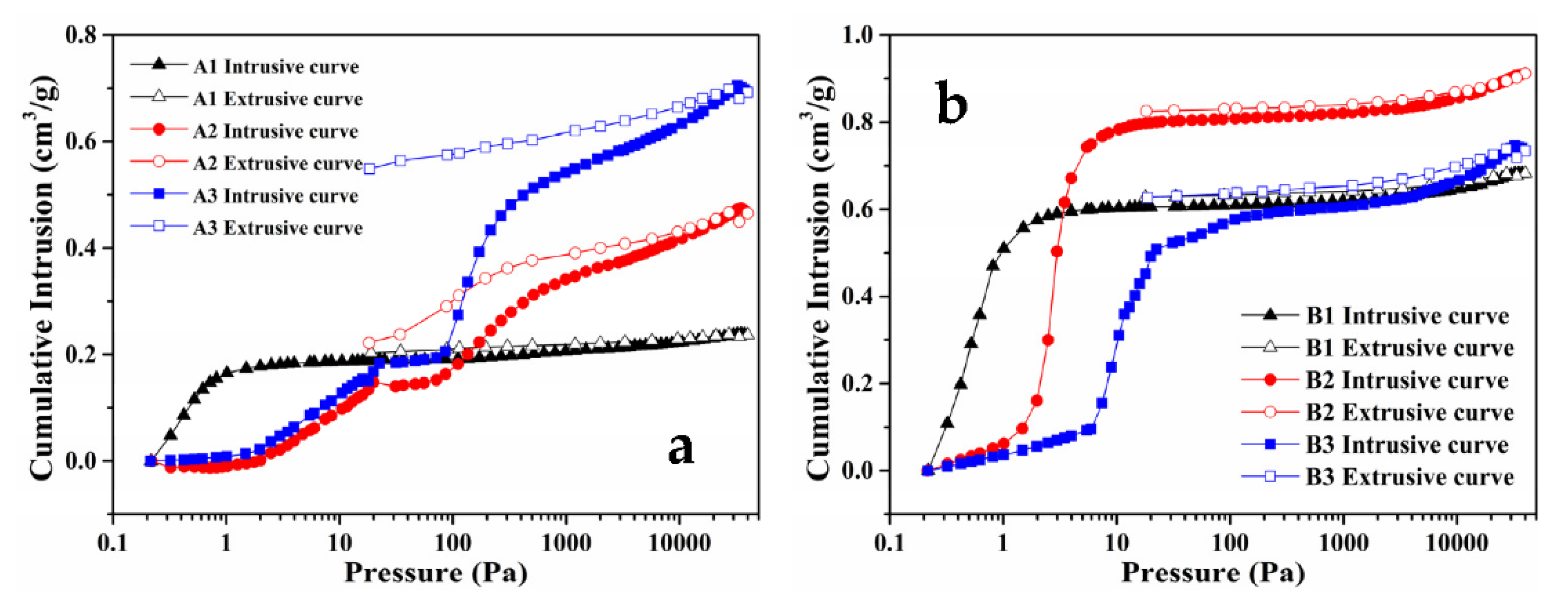
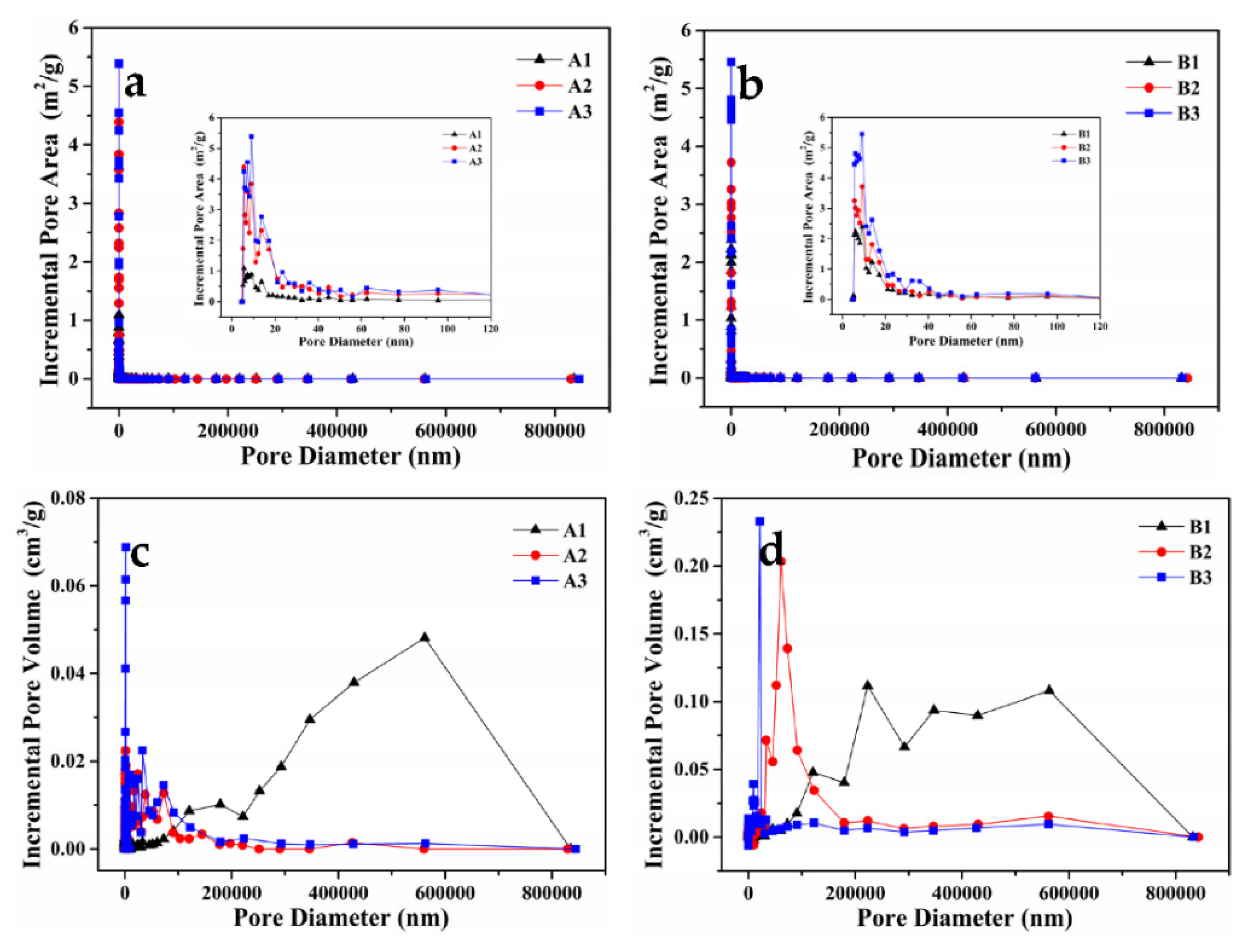
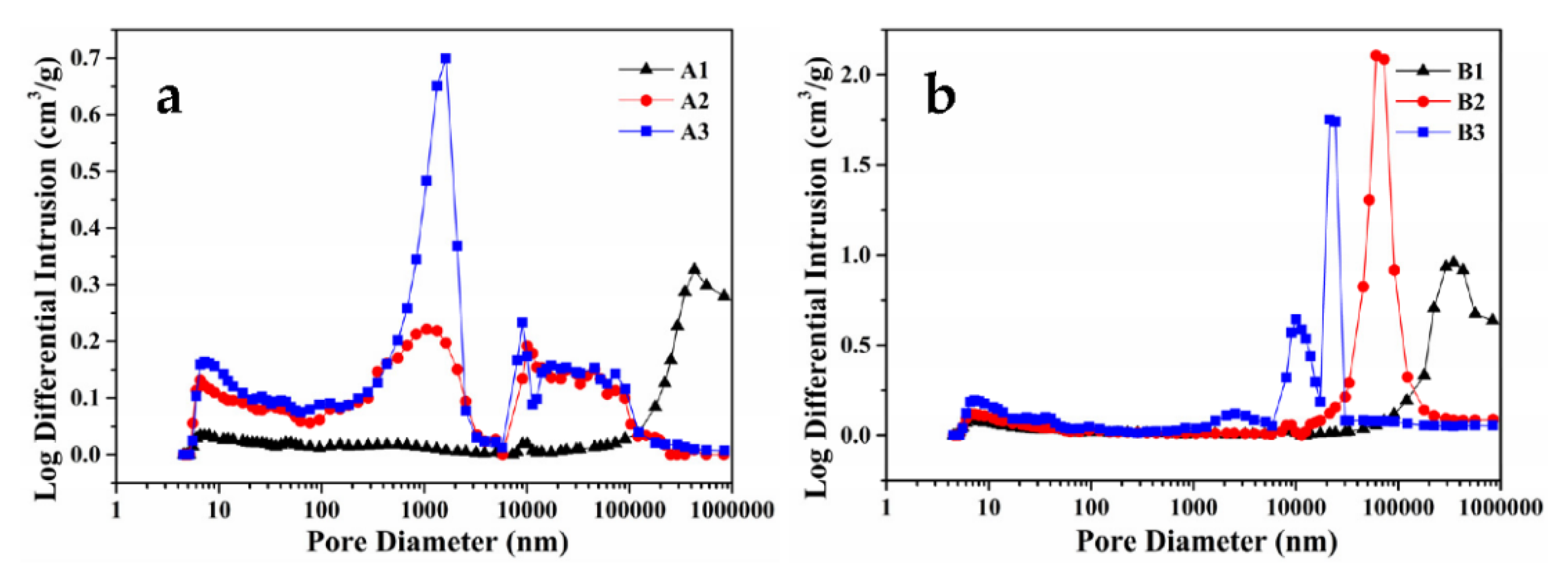
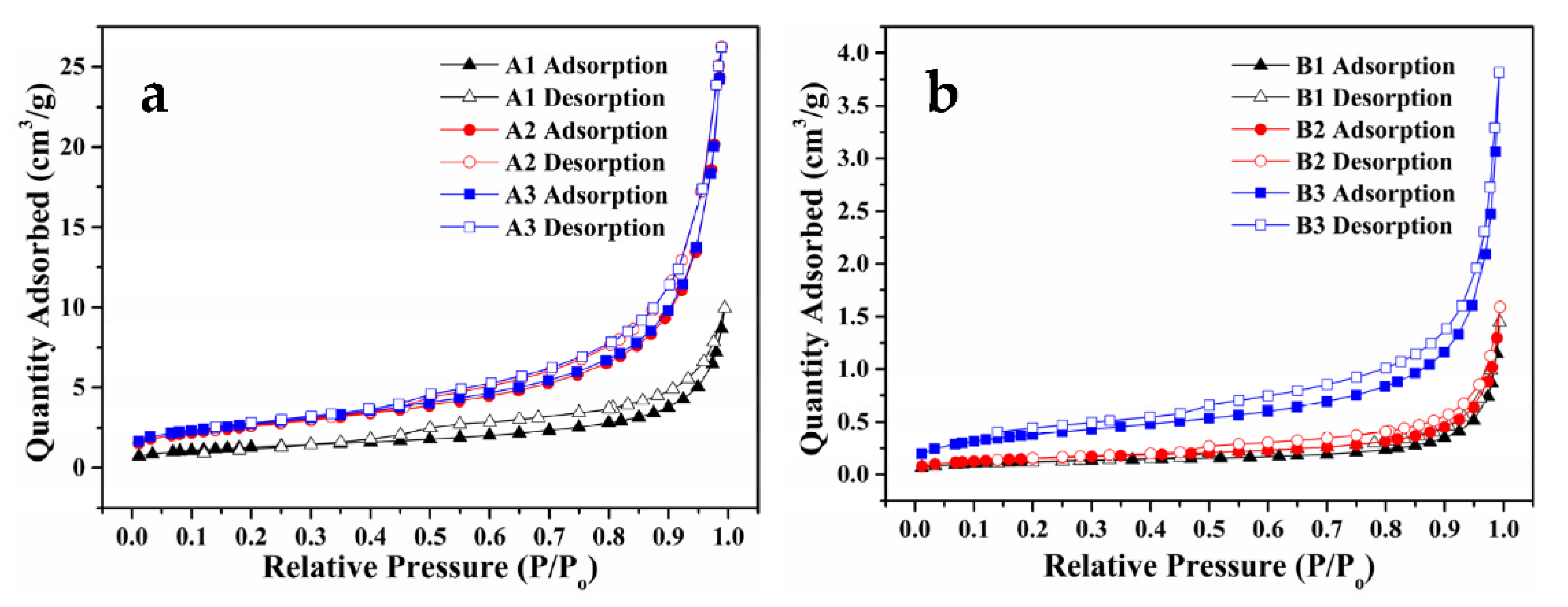
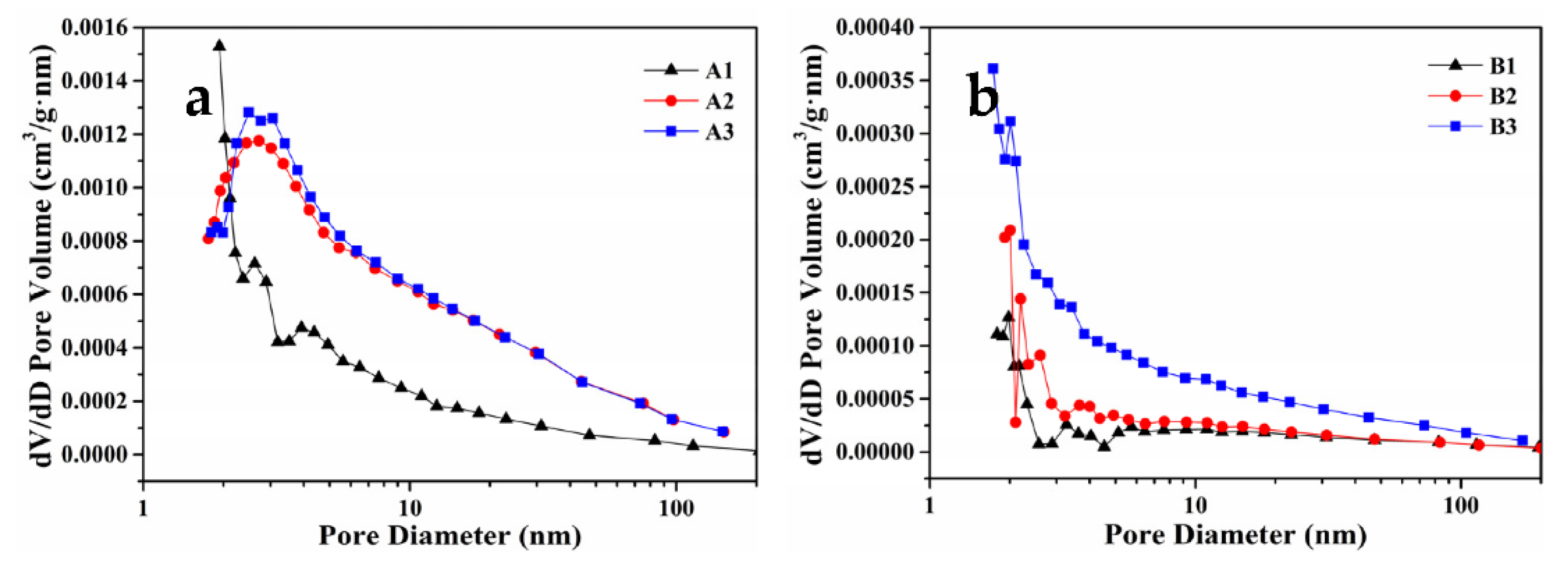
| Samples | A1 | A2 | A3 | B1 | B2 | B3 |
|---|---|---|---|---|---|---|
| Total pore area (m2/g) | 7.14 | 26.78 | 32.10 | 18.75 | 23.60 | 33.31 |
| Micropore pore areas (m2/g) | 0 | 0 | 0 | 0 | 0 | 0 |
| Mesopore pore areas (m2/g) | 6.64 | 23.92 | 28.26 | 18.11 | 22.84 | 31.93 |
| Macropore pore areas (m2/g) | 0.50 | 2.86 | 3.84 | 0.64 | 0.76 | 1.38 |
| Total pore volume (cm3/g) | 0.24 | 0.47 | 0.69 | 0.68 | 0.90 | 0.73 |
| Micropore volume (cm3/g) | 0 | 0 | 0 | 0 | 0 | 0 |
| Mesopore volume (cm3/g) | 0.03 | 0.09 | 0.10 | 0.05 | 0.07 | 0.10 |
| Macropore volume (cm3/g) | 0.21 | 0.38 | 0.59 | 0.63 | 0.83 | 0.63 |
| Porosity (%) | 38.61% | 59.89% | 61.24% | 47.08% | 51.98% | 63.05% |
| Samples | A1 | A2 | A3 | B1 | B2 | B3 |
|---|---|---|---|---|---|---|
| Total specific surface area (m2/g) | 4.63 | 10.37 | 10.52 | 0.38 | 0.54 | 1.46 |
| Micropore specific surface area (m2/g) | 0.29 | 0.35 | 0.34 | 0.05 | 0.04 | 0.14 |
| Mesopore specific surface area (m2/g) | 3.94 | 8.7 | 8.92 | 0.261 | 0.428 | 1.14 |
| Macropore specific surface area (m2/g) | 0.40 | 1.32 | 1.26 | 0.069 | 0.072 | 0.18 |
| Total pore volume (cm3/g) | 0.016 | 0.041 | 0.042 | 0.0022 | 0.0025 | 0.0060 |
| Micropore volume (cm3/g) | 0.00015 | 0.00016 | 0.00016 | 0.00002 | 0.00002 | 0.00006 |
| Mesopore volume (cm3/g) | 0.00755 | 0.01884 | 0.01984 | 0.00058 | 0.00088 | 0.00224 |
| Macropore volume (cm3/g) | 0.0083 | 0.022 | 0.022 | 0.0016 | 0.0016 | 0.0037 |
Publisher’s Note: MDPI stays neutral with regard to jurisdictional claims in published maps and institutional affiliations. |
© 2021 by the authors. Licensee MDPI, Basel, Switzerland. This article is an open access article distributed under the terms and conditions of the Creative Commons Attribution (CC BY) license (https://creativecommons.org/licenses/by/4.0/).
Share and Cite
Zhang, J.; Li, X.; Jiao, J.; Liu, J.; Chen, F.; Song, Z. Comparative Study of Pore Structure Characteristics between Mudstone and Coal under Different Particle Size Conditions. Energies 2021, 14, 8435. https://doi.org/10.3390/en14248435
Zhang J, Li X, Jiao J, Liu J, Chen F, Song Z. Comparative Study of Pore Structure Characteristics between Mudstone and Coal under Different Particle Size Conditions. Energies. 2021; 14(24):8435. https://doi.org/10.3390/en14248435
Chicago/Turabian StyleZhang, Jianguo, Xiyuan Li, Jihong Jiao, Jianbao Liu, Feng Chen, and Zhimin Song. 2021. "Comparative Study of Pore Structure Characteristics between Mudstone and Coal under Different Particle Size Conditions" Energies 14, no. 24: 8435. https://doi.org/10.3390/en14248435





